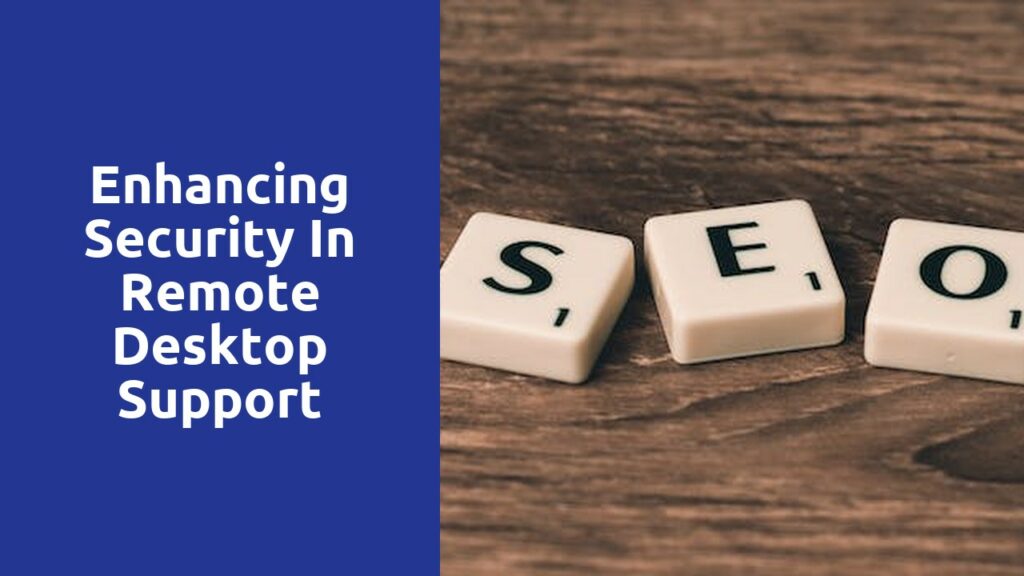The Importance of Secure Remote Desktop Support
Paragraph 1:
Secure remote desktop support has become an essential aspect of our increasingly digitalized world. With the rise of remote work and the ever-evolving cyber threats, businesses and individuals alike need a reliable and secure way to access their desktops remotely. The importance of secure remote desktop support lies in its ability to provide seamless and efficient connectivity while also safeguarding sensitive data and protecting against unauthorized access. It enables employees to work remotely without compromising the security of their organization’s network, ensuring they can access their files and systems from any location with peace of mind.
Paragraph 2:
In addition to the flexibility and convenience it offers, secure remote desktop support also plays a crucial role in enhancing productivity and collaboration. By allowing employees to access their desktops and files remotely, they can seamlessly collaborate with colleagues, share documents, and work on projects together, regardless of their physical location. This eliminates the need for constant back-and-forths of files through emails, leading to time-saving and more streamlined work processes. Furthermore, secure remote desktop support empowers IT teams to provide efficient troubleshooting and support to remote employees, reducing downtime and ensuring seamless workflows. With the increasing dependency on remote work, it is clear that secure remote desktop support is not just a luxury but a necessity in today’s digital landscape.
Understanding the Risks of Unsecured Remote Access
Unsecured remote access poses significant risks in today’s interconnected world. As more and more individuals and organizations rely on remote access to fulfill their daily tasks, the potential for cyberattacks and data breaches increases exponentially. It is essential to understand the dangers associated with unsecured remote access to ensure the safety and integrity of sensitive information.
One of the primary risks of unsecured remote access is unauthorized access to confidential data. Without proper security measures in place, malicious actors can easily infiltrate remote connections, gaining access to sensitive information such as financial records, personal data, and intellectual property. This not only compromises the privacy of individuals and organizations but also opens the door for fraud, identity theft, and other harmful activities. The consequences of a breach can be devastating, leading to significant financial losses, tarnished reputations, and legal repercussions.
Implementing Strong Authentication Measures
With the increasing number of cyber threats and data breaches, organizations must prioritize the implementation of strong authentication measures. Traditional username and password combinations are no longer sufficient to protect sensitive information. One effective approach to enhance authentication is the use of multi-factor authentication (MFA). By requiring multiple forms of identification, such as passwords, biometrics, or security tokens, MFA significantly reduces the risk of unauthorized access.
Another important aspect of implementing strong authentication measures is the regular monitoring and updating of security protocols. It is essential to stay ahead of emerging threats by employing the latest technologies and best practices. This includes regularly reviewing and updating user access controls, implementing stronger password policies, and conducting thorough assessments of any vulnerabilities in the system. By continually evaluating and enhancing authentication measures, organizations can proactively safeguard their critical data and protect against potential security breaches.
Utilizing End-to-End Encryption for Data Protection
In today’s digital age, where data breaches and cyberattacks are becoming increasingly prevalent, ensuring the security and privacy of sensitive information has become paramount. One effective strategy to protect data during transmission is by utilizing end-to-end encryption. End-to-end encryption is a sophisticated technique that encrypts data at the source and decrypts it only at the intended recipient, making it virtually impossible for unauthorized parties to access and decipher the information.
Unlike traditional encryption methods, end-to-end encryption offers a higher level of security by eliminating the need for third-party involvement in the encryption and decryption process. This means that even if a hacker manages to intercept the data, they will only see encrypted gibberish that is utterly useless without the decryption key. By implementing end-to-end encryption, individuals and organizations can ensure that their data remains confidential, regardless of the communication channel used or the network being utilized. From financial transactions to personal messages, end-to-end encryption provides a reliable and robust defense against potential security breaches and unauthorized access.
Best Practices for Secure Password Management
Password management is an essential aspect of maintaining digital security in today’s interconnected world. It is crucial to follow best practices to ensure that your passwords are strong and secure. One key consideration is the complexity of your passwords. Avoid using easily guessable information such as common words, dates of birth, or sequential number patterns. Instead, create passwords that consist of a combination of upper and lower case letters, numbers, and special characters. This will make it much harder for hackers to crack your passwords through brute-force attacks or dictionary-based hacking methods. Additionally, it is a good practice to use separate passwords for each online account you have, as this minimizes the potential damage in case one of your accounts is compromised.
Moreover, regularly updating your passwords is crucial for optimal password management. It is recommended to change your passwords at least every 90 days, or even more frequently for especially sensitive accounts. This helps to mitigate the risk of unauthorized access, particularly if there has been a security breach or you have shared your password with someone who no longer needs access. When changing passwords, create new ones that are unique and not similar to any of your previous passwords. This will prevent the reuse of compromised passwords and further enhance your security. By regularly updating your passwords, you stay one step ahead of potential threats and can significantly reduce the risk of unauthorized access to your sensitive information.
Securing Remote Desktop Applications and Protocols
With the increasing trend of remote work and the rise of cyber threats, it is crucial for organizations to prioritize the security of their remote desktop applications and protocols. Remote desktop applications allow users to access and control a computer from a remote location, making it convenient and efficient for employees to work from anywhere. However, this convenience also brings potential risks and vulnerabilities that cybercriminals can exploit.
The first step in securing remote desktop applications and protocols is to ensure that strong authentication measures are in place. Implementing two-factor authentication (2FA) can greatly enhance the security of remote connections by adding an extra layer of verification. This means that in addition to entering their username and password, users will also need to provide a unique code sent to their mobile device or email. By requiring this additional step, organizations can significantly reduce the risk of unauthorized access to their remote desktop applications and protocols. Additionally, it is important to regularly update and patch remote desktop applications to address any known vulnerabilities and protect against potential exploits. Keeping the software up to date is crucial in mitigating the risk of cyberattacks and maintaining a secure remote work environment.
Related Links
Enhancing Security in Remote Desktop Support
Implementing Remote Desktop Support Policies and Procedures

